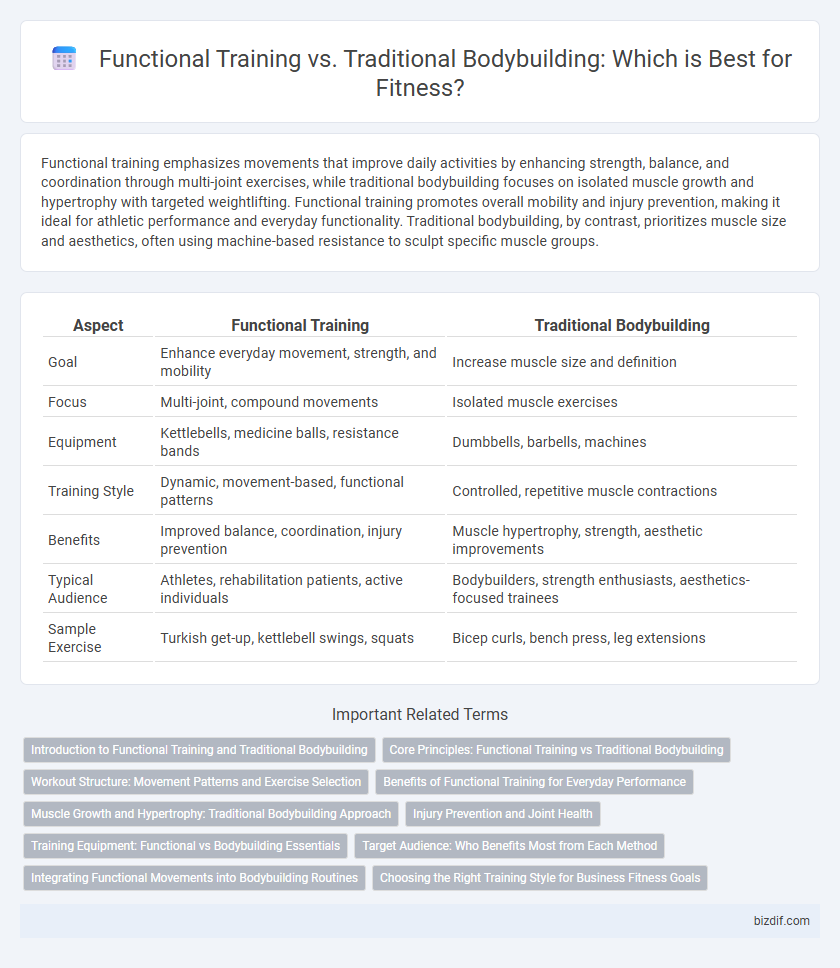Functional training emphasizes movements that improve daily activities by enhancing strength, balance, and coordination through multi-joint exercises, while traditional bodybuilding focuses on isolated muscle growth and hypertrophy with targeted weightlifting. Functional training promotes overall mobility and injury prevention, making it ideal for athletic performance and everyday functionality. Traditional bodybuilding, by contrast, prioritizes muscle size and aesthetics, often using machine-based resistance to sculpt specific muscle groups.
Table of Comparison
| Aspect | Functional Training | Traditional Bodybuilding |
|---|---|---|
| Goal | Enhance everyday movement, strength, and mobility | Increase muscle size and definition |
| Focus | Multi-joint, compound movements | Isolated muscle exercises |
| Equipment | Kettlebells, medicine balls, resistance bands | Dumbbells, barbells, machines |
| Training Style | Dynamic, movement-based, functional patterns | Controlled, repetitive muscle contractions |
| Benefits | Improved balance, coordination, injury prevention | Muscle hypertrophy, strength, aesthetic improvements |
| Typical Audience | Athletes, rehabilitation patients, active individuals | Bodybuilders, strength enthusiasts, aesthetics-focused trainees |
| Sample Exercise | Turkish get-up, kettlebell swings, squats | Bicep curls, bench press, leg extensions |
Introduction to Functional Training and Traditional Bodybuilding
Functional training emphasizes multi-joint, compound movements that improve everyday strength, mobility, and coordination through exercises that mimic real-life activities. Traditional bodybuilding focuses on isolated muscle group workouts designed to maximize hypertrophy and muscle definition using machines and free weights. Functional training enhances dynamic performance and injury prevention, while bodybuilding prioritizes muscle size and symmetry.
Core Principles: Functional Training vs Traditional Bodybuilding
Functional training emphasizes multi-joint movements and dynamic exercises that improve overall mobility, stability, and real-life performance by engaging the core and stabilizer muscles. Traditional bodybuilding concentrates on isolated muscle group exercises to increase hypertrophy and muscle definition through repetitive, controlled motions. Both approaches prioritize strength development but differ in application, with functional training targeting movement efficiency and traditional bodybuilding focusing on muscle size and symmetry.
Workout Structure: Movement Patterns and Exercise Selection
Functional training emphasizes multi-joint, compound movements that mimic everyday activities, enhancing overall mobility, stability, and coordination. Traditional bodybuilding focuses on isolated muscle group exercises with controlled, repetitive movements designed to maximize muscle hypertrophy and definition. Workout structure in functional training often integrates dynamic, full-body patterns, while bodybuilding prioritizes targeted muscle activation through machines and free weights.
Benefits of Functional Training for Everyday Performance
Functional training enhances everyday performance by improving strength, balance, and coordination through movement patterns mimicking real-life activities. Unlike traditional bodybuilding, which isolates muscles for aesthetic goals, functional training develops compound movements that boost overall mobility and injury prevention. This approach increases efficiency in daily tasks and supports long-term physical health.
Muscle Growth and Hypertrophy: Traditional Bodybuilding Approach
Traditional bodybuilding prioritizes targeted muscle growth through isolation exercises and controlled, high-volume sets to maximize hypertrophy. Emphasis on progressive overload and muscle fatigue stimulates muscle fiber enlargement, promoting significant increases in muscle size. Structured training splits allow focused development of specific muscle groups, enhancing definition and symmetry.
Injury Prevention and Joint Health
Functional training emphasizes multi-joint, dynamic movements that enhance overall mobility and reduce the risk of injury by mimicking real-life activities, promoting joint stability and balanced muscle development. Traditional bodybuilding often isolates muscles with repetitive motions, which can increase stress on specific joints and elevate the risk of overuse injuries if not balanced with proper recovery and flexibility work. Integrating functional training into a bodybuilding routine supports injury prevention by improving neuromuscular coordination and joint resilience.
Training Equipment: Functional vs Bodybuilding Essentials
Functional training relies on versatile equipment such as kettlebells, resistance bands, medicine balls, and stability balls, designed to enhance real-life movement patterns and improve overall athletic performance. Traditional bodybuilding centers around machines, free weights like dumbbells and barbells, and bench presses, targeting muscle isolation and hypertrophy for aesthetic muscle growth. Choosing functional training equipment supports dynamic, multi-joint exercises, while bodybuilding essentials cater to focused muscle strengthening and sculpting.
Target Audience: Who Benefits Most from Each Method
Functional training primarily benefits athletes, older adults, and individuals seeking improved everyday movement by enhancing strength, balance, and coordination through compound, multi-joint exercises. Traditional bodybuilding appeals mainly to those focused on muscle hypertrophy, aesthetic development, and isolated muscle growth, including bodybuilders and fitness enthusiasts aiming for physique sculpting. Each method targets distinct goals and populations, making the choice dependent on personal fitness objectives and lifestyle needs.
Integrating Functional Movements into Bodybuilding Routines
Integrating functional movements into bodybuilding routines enhances overall performance by improving mobility, balance, and core stability, which traditional bodybuilding often overlooks. Exercises like kettlebell swings, Turkish get-ups, and compound lifts mimic real-life movements, promoting greater muscular coordination and injury prevention. This fusion optimizes strength gains while supporting practical fitness and long-term athleticism.
Choosing the Right Training Style for Business Fitness Goals
Functional training enhances overall movement patterns and daily performance by targeting multiple muscle groups simultaneously, making it ideal for clients seeking improved mobility and injury prevention. Traditional bodybuilding prioritizes muscle hypertrophy and symmetry through isolated exercises, catering to those aiming for aesthetic muscle development and strength. Selecting the right training style depends on business fitness goals, whether emphasizing practical fitness outcomes or visual transformation to attract and retain clients effectively.
Functional training vs Traditional bodybuilding Infographic

 bizdif.com
bizdif.com